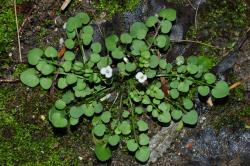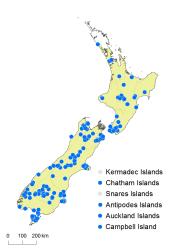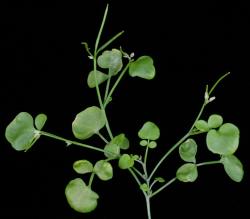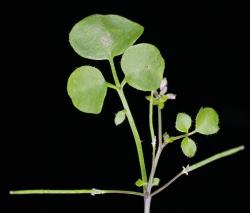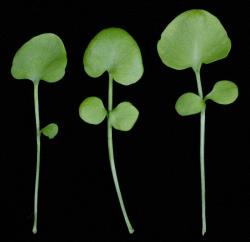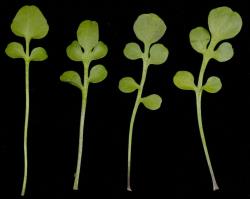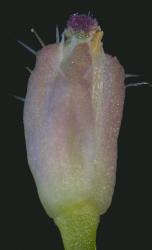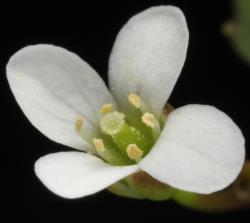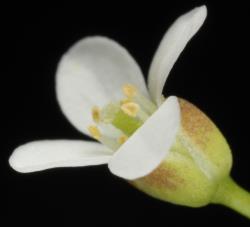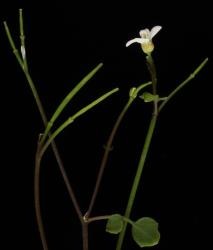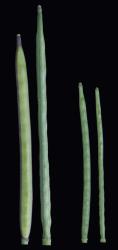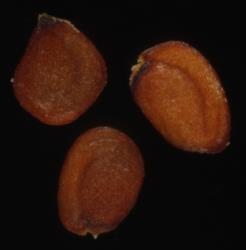- ≡ Cardamine hirsuta var. corymbosa (Hook.f.) Hook.f., Handb. New Zealand Fl. 12 (1864)
Perennial herb, single rosette or with short lateral branches. Leaves up to 120 mm long, pinnatifid or pinnatisect; lamina 4.0–55.0 × 2.5–25.0 mm, green, membranous to semi-coriaceous, glabrous to sparsely hairy on abaxial and adaxial surfaces, margin and petiole; hairs 0.3–0.4 mm long, spreading to patent; petiole up to 65 mm long. Terminal pinna 2.0–15.0 × 2.0–16.0 mm, simple, orbicular, broadly orbicular, orbicular-reniform to broadly orbicular-reniform; margin entire, sometimes shallowly lobed, with 2 usually indistinct hydathodes; apex obtuse, usually with a indistinct hydathode; base cordate, truncate or obtuse. Lateral pinnae 2–6, 1.0–8.0 × 1.0–10.0, orbicular, broadly orbicular, to broadly elliptic-orbicular; margin entire, occasionally weakly lobed; apex obtuse; base obtuse to cuneate, often oblique; petiolule 0.2–6.0 mm long, often appearing ± sessile. Cauline leaves similar to rosette leaves but smaller and with fewer lateral pinnae, pinnae bases attenuate to obtuse; terminal pinna up to 14.0 × 6.0 mm, lateral pinnae up to 8.0 × 4.5 mm. Inflorescence with solitary flowers or 1–5 corymbs, corymbs 2–8-flowered; peduncle up to 150 mm long, 0.5–1.0 mm diam. at base, spreading to ascending, glabrous to sparsely hairy near base. Pedicels 5.0–50.0 mm long, 0.3–0.7 mm diam., terete, glabrous to sparsely hairy. Sepals 1.4–2.9 × 0.5–1.8 mm, elliptic-oblong to obovate, saccate, green to red-brown; glabrous to sparsely hairy, hairs spreading to patent, 0.2–0.3 mm long; margin white and membranous, apex obtuse, base truncate. Petals 1–4 or absent; 3.5–5.5 × 1.8–2.3 mm, white, limb obovate; apex obtuse; base cuneate, tapering to a 0.7–1.0 mm long claw. Stamens 4–6; median filaments 2–4, 1.8–2.4 mm long; lateral filaments 2, 1.5–1.7 mm long; anthers 0.3–0.4 mm long, cream to pale yellow, when dehiscent held at a similar height to or slightly below the stigma. Ovary 1.9–2.3 mm long, 0.4–0.5 mm diam., ± terete, green, glabrous; ovules 28–34; style 0.1–0.2 mm long, ± terete; stigma 0.3–0.4 mm diam., white or rarely purple. Siliques 12.0–28.0 × 0.9–1.4 mm, glabrous, style 0.3–1.2 mm long; valves green to purple-brown at maturity and when dehiscent; replum 0.3–0.5 mm wide. Seeds 0.8–1.0 mm long, 0.7–0.9 mm wide, 0.3–0.4 mm thick, orbicular to broadly oblong, light green to light yellow-brown; wing absent.
North Island: Auckland, Volcanic Plateau, Taranaki, Gisborne, Southern North Island.
South Island: Western Nelson, Sounds Nelson, Marlborough, Westland, Canterbury, Otago, Southland, Fiordland.
Stewart Island.
Chatham Islands.
Campbell Island.
Auckland Islands.
Antipodes Island.
Cardamine corymbosa indigenous to New Zealand as it also occurs on Macquarie Island (Copson 1984). In New Zealand, C. corymbosa has a widespread distribution, occurring throughout the North Island, South Island, Chatham Islands, Stewart Island, the subantarctic Campbell Island and Auckland Islands, as well as many smaller islands. The identity of plants from Macquarie Island has been problematic as they have been placed in three species. For example, Allan (1961) recorded C. subcarnosa, Hewson (1982) and Webb et al. (1988) treated the species as C. depressa, whereas Copson (1984) and Heenan (2017) considered it to be C. corymbosa.
Cardamine corymbosa is naturalised in Australia (Thompson 1996, 2003), North America (Post et al. 2009, 2011), Britain (Braithwaite 1991, as C. uniflora; Stace 1997), and western Europe (Netherlands and Belgium: Groom et al. 2011; Hoste et al. 2008). Hewson (1982) recorded C. aff. corymbosa from Tasmania, and Thompson (1996, 2003) regarded C. corymbosa as naturalised in Australia (including Tasmania), stating it occurred in gardens and urban areas. Therefore, C. corymbosa in Australia should be regarded as both indigenous (Macquarie Island) and naturalised (mainland Australia and Tasmania).
Cardamine corymbosa occurs in a wide variety of habitats, including crevices, ledges and shaded overhangs on rock outcrops and bluffs, among rocky debris, on stream banks, open sites in forest and forest margins, among herbs and grasses in turf vegetation, in muddy hollows, among damp rocks, on seasonally dry or periodically inundated surfaces of tarn and lake margins, and open and dry areas under mānuka and kānuka forest. It often occurs on disturbed surfaces associated with bird burrows, margins of scree, eroded cliff edges, slips and vehicle tracks. It is also a weed in urban areas, where it occurs in lawns, concrete drains, path edges, shadehouses and glasshouses, in potted plants, and on bare-soil ornamental gardens.
Cardamine corymbosa is assessed as having a conservation status of Not Threatened (de Lange et al. 2018).
Flowering August–May; Fruiting August–May.
The taxonomic circumscription of C. corymbosa has been refined by Heenan (2017) with the recognition of new species such as C. grandiscapa, C. heleniae, C. integra and C. sinuatifolia. These new species were previously included in a much broader concept of C. corymbosa (e.g., Pritchard 1957; Allan 1961; Webb et al. 1988), and can be distinguished on the basis of leaf, flower, and silique characters. However, there remains unresolved variation in C. corymbosa (Heenan 2017). Alpine forms of C. corymbosa typically have semi-coriaceous leaves and larger and stouter siliques (e.g., CHR 511692, Old Man Range, Otago; CHR 312893, Craigieburn Valley, Canterbury). In contrast, lowland forms of C. corymbosa tend to mostly have membranous leaves and slightly smaller and more slender siliques (e.g., CHR 636089, Pareora River gorge, Canterbury). Heenan (2017) recommended further study to resolve this variation.



